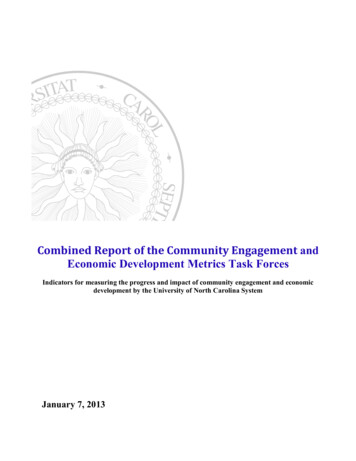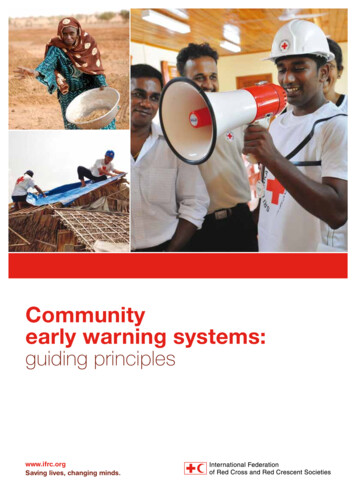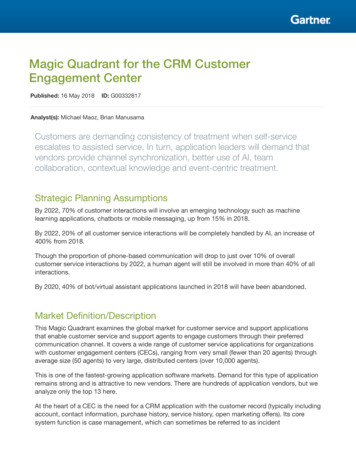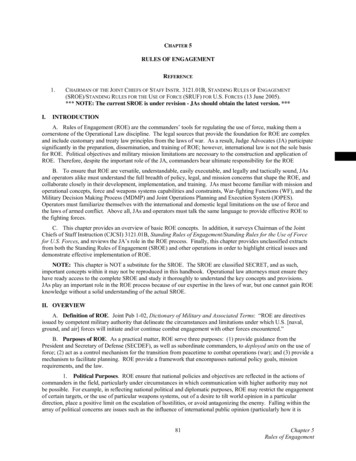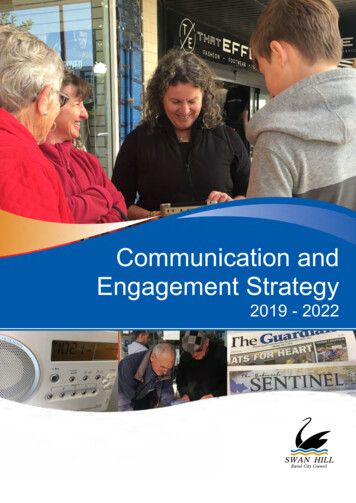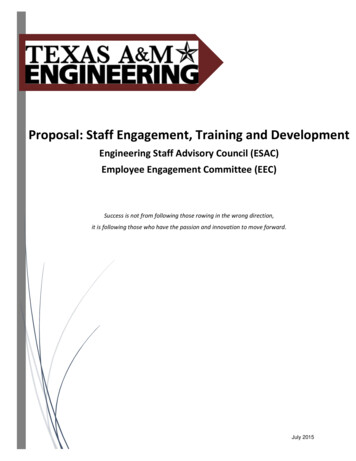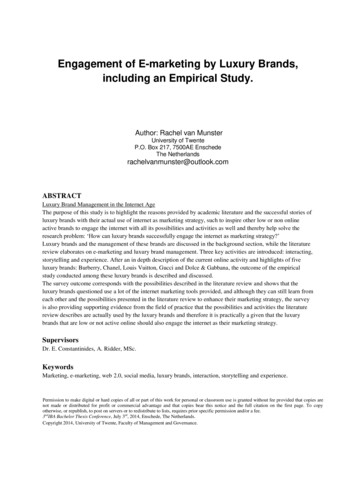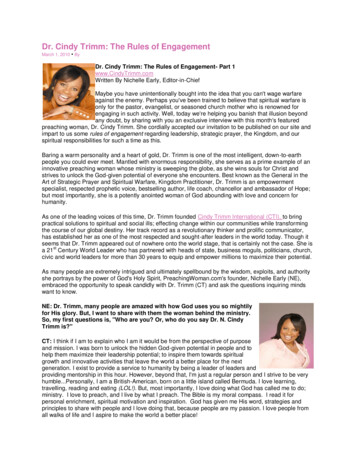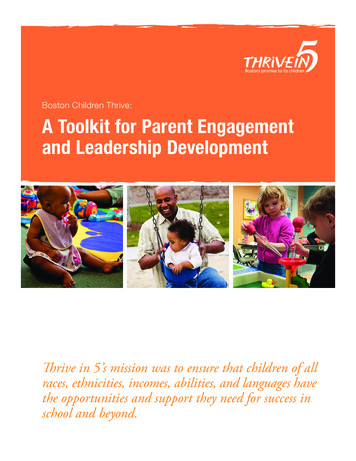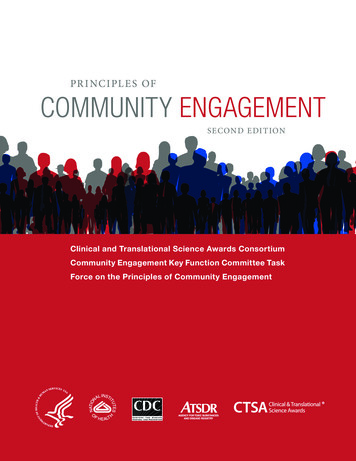
Transcription
PR I NC I PL E S OFCOMMUNITY ENGAGEMENTSE C ON D E DI T IONClinical and Translational Science Awards ConsortiumCommunity Engagement Key Function Committee TaskForce on the Principles of Community Engagement
PR I NC I PL E S OFCOMMUNITY ENGAGEMENTSE C ON D E DI T IONClinical and Translational Science Awards ConsortiumCommunity Engagement Key Function Committee TaskForce on the Principles of Community EngagementNIH Publication No. 11-7782Printed June 2011
TABLE OF CONTENTSCTSA Community Engagement Key Function CommitteeTask Force on the Principles of Community Engagement (Second Edition). . . . . . . . . . . . . . . . . . . . . ivPublication Development . . . . . . . . . . . . . . . . . . . . . . . . . . . . . . . . . . . . . . . . . . . . . . . . . . . . . . . . viForeword . . . . . . . . . . . . . . . . . . . . . . . . . . . . . . . . . . . . . . . . . . . . . . . . . . . . . . . . . . . . . . . . . . . . ixExecutive Summary . . . . . . . . . . . . . . . . . . . . . . . . . . . . . . . . . . . . . . . . . . . . . . . . . . . . . . . . . . . xiiiChapter 1: Community Engagement: Definitions and OrganizingConcepts from the Literature . . . . . . . . . . . . . . . . . . . . . . . . . . . . . . . . . . . . . . . . . . . . . . 1Chapter 2: Principles of Community Engagement . . . . . . . . . . . . . . . . . . . . . . . . . . . . . . . . . . . . . . 43Chapter 3: Successful Examples in the Field . . . . . . . . . . . . . . . . . . . . . . . . . . . . . . . . . . . . . . . . . . 55Chapter 4: Managing Organizational Support for Community Engagement . . . . . . . . . . . . . . . . . . . 91Chapter 5: Challenges in Improving Community Engagement in Research . . . . . . . . . . . . . . . . . . . 107Chapter 6: The Value of Social Networking in Community Engagement . . . . . . . . . . . . . . . . . . . . . 149Chapter 7: Program Evaluation and Evaluating Community Engagement . . . . . . . . . . . . . . . . . . . . 161Chapter 8: Summary . . . . . . . . . . . . . . . . . . . . . . . . . . . . . . . . . . . . . . . . . . . . . . . . . . . . . . . . . . 183Appendix A: Acronyms . . . . . . . . . . . . . . . . . . . . . . . . . . . . . . . . . . . . . . . . . . . . . . . . . . . . . . . . 189iii
CTSA Community Engagement Key Function Committee Task Force on thePrinciples of Community Engagement (Second Edition)Donna Jo McCloskey, RN, PhD, National Center for ResearchResources, NIH (Chair)Sergio Aguilar-Gaxiola, MD, PhD, University of California, Davis (Co-Chair)J. Lloyd Michener, MD, Duke University (Co-Chair)Tabia Henry Akintobi, PhD, MPH, Morehouse School of MedicineAnn Bonham, PhD, Association of American Medical CollegesJennifer Cook, MPH, Duke UniversityTamera Coyne-Beasley, MD, MPH, University of North Carolinaat Chapel HillAnn Dozier, PhD, University of Rochester School of Medicine and DentistryRobert Duffy, MPH, University of California, DavisMilton (Mickey) Eder, PhD, University of Chicago, Access CommunityHealth NetworkPaul Fishman, PhD, University of WashingtonJo Anne Grunbaum, EdD, Centers for Disease Control and PreventionSheila Gutter, PhD, Weill Cornell Medical CollegeKaren Hacker, MD, MPH, Harvard UniversityMichael Hatcher, DrPH, Agency for Toxic Substances and Disease RegistrySuzanne Heurtin-Roberts, PhD, MSW, National Cancer Institute, NIHMark Hornbrook, MD, Kaiser Permanente Center for Health ResearchShantrice Jones, MPH, Centers for Disease Control and PreventionMichelle Lyn, MBA, MHA, Duke UniversityMary Anne McDonald, DrPH, MA, Duke UniversityDavid Meyers, MD, Agency for Healthcare Research and QualityBarbara Moquin, PhD, APRN, National Center for Complementaryand Alternative Medicine, NIHPatricia Mullan, PhD, University of MichiganNancy Murray, DrPH, MA, University of Texas Health Science Centerat HoustonRuby Neville, MSW, Substance Abuse and Mental HealthServices AdministrationCheryl Perry, PhD, University of Alabama at BirminghamDana Sampson, MS, MBA, Office of Behavioral and Social SciencesResearch, NIHMina Silberberg, PhD, Duke UniversityMeryl Sufian, PhD, National Center for Research Resources, NIHStephen Updegrove, MD, MPH, Yale UniversityDavid Warner, MD, Mayo ClinicCharlene Raye Weir, RN, PhD, University of UtahSharrice White-Cooper, MPH, Centers for Disease Control and Preventioniv
Editorial and Research StaffMina Silberberg, PhD, Duke University (Chair)Jennifer Cook, MPH, Duke UniversityCheryl Drescher, BEd, Duke UniversityDonna Jo McCloskey, RN, PhD, National Center for ResearchResources, NIHSarah Weaver, MPH, Duke UniversityLinda Ziegahn, PhD, University of California, DavisExternal ReviewersBarbara Alving, MD, FCCP, National Center for Research Resources, NIHAhmed Calvo, MD, MPH, Health Resources and Services AdministrationTeresa Cullen, MD, MS, Indian Health ServiceWilliam Elwood, PhD, Office of Behavioral and Social SciencesResearch, NIHCarol Ferrans, PhD, RN, FAAN, University of Illinois at ChicagoSarah Greene, MPH, University of WashingtonThelma Hurd, MD, University of Texas Health Science Centerat San AntonioLaurel Leslie, MD, MPH, Tufts UniversityLeandris Liburd, MPH, PhD, Centers for Disease Control and PreventionDoriane Miller, MD, University of ChicagoMeredith Minkler, DrPH, University of California, BerkeleyJim Mold, MD, University of OklahomaSylvia L. Parsons, National Center for Research Resources, NIHValerie Robison, DDS, MPH, PhD, Centers for Disease Controland PreventionEduardo Simoes, MD, MSc, MPH, Centers for Disease Controland PreventionBernard Talbot, MD, PhD, National Center for Research Resources, NIHNina Wallerstein, DrPH, University of New MexicoAnne Willoughby, MD, MPH, National Center for Research Resources, NIHv
PUBLICATION DEVELOPMENTThis publication was developed as part of the work of the Clinical andTranslational Science Awards (CTSA) Consortium’s Community EngagementKey Function Committee. Recognizing that community involvement is essential to the identification of health concerns and interventions, the Committeecreated a task force on updating the 1997 publication Principles of CommunityEngagement, published by the Centers for Disease Control and Prevention andthe Agency for Toxic Substances and Disease Registry. This project has beenfunded in whole with federal funds from the National Center for ResearchResources, National Institutes of Health, through the CTSA program, part ofthe Roadmap Initiative, Re-Engineering the Clinical Research Enterprise. Themanuscript was approved by the CTSA Consortium Publications Committee.Publication development was a collaborative effort of the CTSA CommunityEngagement Key Function Committee, which included members from theNational Institutes of Health, Agency for Toxic Substances and Disease Registry,and Centers for Disease Control and Prevention. This publication is in thepublic domain and may be reprinted or copied without permission.About the DevelopersThe National Institutes of Health is a part of the U.S. Department of Healthand Human Services. Its mission is making important medical discoveriesthat improve health and save lives (www.nih.gov).The Centers for Disease Control and Prevention is a part of the U.S. Departmentof Health and Human Services and is the nation’s prevention agency. Its mission is to promote health and quality of life by preventing and controllingdisease, injury, and disability (www.cdc.gov).The Agency for Toxic Substances and Disease Registry is a part of the U.S.Department of Health and Human Services and is a federal public healthagency. Its mission is to prevent exposure and adverse human health effectsand diminished quality of life associated with exposure to hazardous substances from waste sites, unplanned releases, and other sources of pollutionpresent in the environment (www.atsdr.cdc.gov).vi
For further information on the CTSA Consortium and the CommunityEngagement Key Function Committee, please visit www.ctsaweb.org.The findings and conclusions in this report are those of the authors and do notnecessarily represent the official position of the Centers for Disease Controland Prevention, the Agency for Toxic Substances and Disease Registry, or theNational Institutes of Health.Editorial support was provided under the American Recovery and ReinvestmentAct supplemental funding to the Duke CTSA, grant number UL1RR024128,and by Palladian Partners, Inc., contract number 3035468.vii
Foreword
FOREWORDAs Surgeon General, I am privileged to serve as “America’s Doctor,” overseeing the operations of the U.S. Public Health Service and providing Americanswith the best scientific information available on how to improve their healthand reduce the risk of illness and injury.In this capacity, and from my many years of family practice, I am convincedthat Americans need to live and work in environments where they can practicehealthy behaviors and obtain quality medical care. Social, cultural, physical,and economic foundations are important factors in the overall health of thecommunity. We must use our resources to increase availability of healthyfoods, ensure that neighborhoods have safe places for physical activity, andprovide access to affordable, high-quality medical services.Creating these healthy environments for people of all ages will require theiractive involvement in grassroots efforts. Private citizens, community leaders,health professionals, and researchers will need to work together to make thechanges that will allow such environments to flourish.Across the United States, coalitions are working together to create change,and we are already seeing results. The most effective collaborations includerepresentation from various sectors—businesses, clinicians, schools, academia,government, and the faith-based community.This work is not easy, but it is essential. When Principles of CommunityEngagement was first published in 1997, it filled an important vacuum, providing community members, health professionals, and researchers with clearprinciples to guide and assess their collaborative efforts. The need for suchguidance has not lessened in the subsequent years. Our health challengescontinue. Support for collaborative work has grown, but with this growingsupport has come an increasing volume and diversity of initiatives, terminology, approaches, and literature.This new edition of Principles adheres to the same key principles laid out inthe original booklet. It distills critical messages from the growing body ofinformation and commentary on this topic. At the same time, it provides morexi
detailed practical information about the application of the principles, and itresponds to changes in our larger social context, including the increasing useof “virtual communities” and the growing interest in community-engagedhealth research.As we continue to try to improve our nation’s health, we must work togetherand keep in mind the community contexts that shape our health and well-being.This is the charge and the challenge laid out in these pages.Regina M. Benjamin, M.D., M.B.A.Vice Admiral, U.S. Public Health ServiceSurgeon Generalxii
Executive Summary
EXECUTIVE SUMMARYInvolving the community and collaborating with its members are cornerstonesof efforts to improve public health. In recent years, for example, communityengagement and mobilization have been essential to programs addressingsmoking cessation, obesity, cancer, heart disease, and other health concerns(Ahmed et al., 2010; Minkler et al., 2008). In October 1995, recognizing theimportance of involving the community, the Centers for Disease Control andPrevention (CDC) established the Committee for Community Engagement,which was composed of representatives from across CDC and the Agency forToxic Substances and Disease Registry (ATSDR). Two years later, that committee developed the booklet Principles of Community Engagement, whichwas published by CDC and ATSDR. Principles defined community engagement as “the process of working collaboratively with groups of people whoare affiliated by geographic proximity, special interests, or similar situationswith respect to issues affecting their well-being” (CDC, 1997, p. 9). We willrefer to this second edition as a primer rather than a booklet because of itsexpanded size and scope.The challenges faced by the health system in 1997 are not so different fromthose of today, but the scope, scale, and urgency of these problems have allsharply increased. In 1997, the newly enacted Children’s Health InsuranceProgram expanded access to health care for millions of children; today thenewly enacted Patient Protection and Affordable Care Act expands accessto tens of millions of people of all ages. In 1997, obesity rates had reached20–24% in three states; today, nine states have obesity rates over 30% (CDC,2010), and the U.S. faces unprecedented increases in the prevalence of chronicdiseases, such as diabetes, hypertension, and cardiovascular disorders (CDC,2009). Not surprisingly, community engagement is increasingly recognized asa vital component of efforts to expand access to quality care, prevent disease,and achieve health equity for all Americans.Although the principles of community engagement laid out in 1997 have notchanged, the body of knowledge supporting them has grown, and more agencies and organizations are involved in promoting community engagement andcommunity-engaged research. CDC is now joined by the National Institutes ofHealth, the Health Resources and Services Administration, the U.S. Departmentxv
of Veterans Affairs, and other federal agencies, academic institutions, andcommunity partners in advancing knowledge about community engagementand in promoting its use to solve some of our more challenging problems.Principles of Community Engagement (Second Edition) provides public healthprofessionals, health care providers, researchers, and community-based leadersand organizations with both a science base and practical guidance for engagingpartners in projects that may affect them. The principles of engagement canbe used by people in a range of roles, from the program funder who needs toknow how to support community engagement to the researcher or communityleader who needs hands-on, practical information on how to mobilize themembers of a community to partner in research initiatives. In addition, thisprimer provides tools for those who are leading efforts to improve populationhealth through community engagement.In the context of engagement, “community” has been understood in twoways. It is sometimes used to refer to those who are affected by the healthissues being addressed. This use recognizes that the community as definedin this way has historically been left out of health improvement efforts eventhough it is supposed to be the beneficiary of those efforts. On the otherhand, “community” can be used in a more general way, illustrated by referring to stakeholders such as academics, public health professionals, andpolicy makers as communities. This use has the advantage of recognizingthat every group has its own particular culture and norms and that anyonecan take the lead in engagement efforts. In this second edition of Principlesof Community Engagement, we recognize the need for particular attention toengagement of communities affected by health issues. We also promote theidea that engagement for health improvement can be initiated and led by the“lay” community rather than professional groups. Regardless, we recognizethat the groups involved in community engagement have their own particularnorms and that all partners in a collaboration will have lessons to learn abouteach other and the collaborative process. Moreover, we fully appreciate that allwho are involved in engaging a community must be responsive to the needsof that community as defined by the community itself.In practice, community engagement is a blend of science and art. The sciencecomes from sociology, political science, cultural anthropology, organizationaldevelopment, psychology, social work, and other disciplines, and organizingconcepts are drawn from the literature on community participation, communityxvi
mobilization, constituency building, community psychology, and culturalinfluences. The art comes from the understanding, skill, and sensitivity usedto apply and adapt the science in ways that fit the community of interest andthe purposes of specific engagement efforts. The results of these efforts maybe defined differently and can encompass a broad range of structures (e.g.,coalitions, partnerships, collaborations), but they all fall under the generalrubric of community engagement and are treated similarly in this primer.This primer can serve as a guide for understanding the principles of community engagement for those who are developing or implementing a communityengagement plan, or it can be a resource for students or faculty. Communityprocesses can be complex and labor-intensive, and they require dedicatedresources such as time, funding, and people with the necessary skills. Leaderseverywhere are struggling with how to make the right choices as they try toimprove health care services and promote individual and population health.Readers of this primer may find that a fuller understanding of communityengagement will facilitate and promote its use and thus advance the healthof all of our communities.ORGANIZATION OF THE PRINCIPLES OF COMMUNITY ENGAGEMENTThe first of this primer’s eight chapters reviews organizing concepts, models,and frameworks from the literature, and the second chapter introduces theprinciples of community engagement, which are rooted in that literature. Asin the first edition, one chapter contains a series of community case examples(Chapter 3) taken from the literature on community engagement that link tothe principles described in Chapter 2. Chapter 4 describes how to manageorganizational support for community engagement; this chapter reflects ourgrowing awareness of the challenges of putting community engagement intopractice. Chapter 5 addresses the increased interest in community-engagedresearch, and Chapter 6 deals with the rapidly changing world of socialnetworking. Chapter 7 deals with evaluation, and Chapter 8 offers a briefsummary and closing remarks.This primer was written as an integrated whole, with later chapters buildingon those that come before. Even so, the chapters can also stand alone andbe used as needed. This is by intention, as we wish to meet the needs of ourdiverse audiences. We hope that whoever uses Principles (Second Edition)finds it helpful in assisting their efforts to engage communities.xvii
REFERENCESAhmed SM, Palermo AG. Community engagement in research: frameworks for education and peer review. American Journal of Public Health2010;100(8):1380-1387.Centers for Disease Control and Prevention. Chronic diseases. The power toprevent, the call to control: at a glance 2009. Atlanta (GA): Centers for DiseaseControl and Prevention; 2009. Retrieved from ations/AAG/pdf/chronic.pdf.Centers for Disease Control and Prevention. Obesity trends among U.S.adults between 1985 and 2009. Atlanta (GA): Centers for Disease Control andPrevention; 2010. Retrieved from http://www.cdc.gov/obesity/downloads/obesity trends 2009.pdf.Centers for Disease Control and Prevention. Principles of communityengagement (1st ed.). Atlanta (GA): CDC/ATSDR Committee on CommunityEngagement; 1997.Minkler M, Wallerstein N. The growing support for CBPR. In: Minkler M,Wallerstein N (editors). Community-based participatory research for health:from process to outcomes (2nd ed., p. 544). San Francisco: Jossey-Bass; 2008.xviii
Community Engagement:Definitions and Organizing Concepts from the Literature
Chapter 1Community Engagement:Definitions and Organizing Concepts from the LiteratureDonna Jo McCloskey, RN, PhD, (Chair), Mary Anne McDonald, DrPH, MA, Jennifer Cook,MPH, Suzanne Heurtin-Roberts, PhD, MSW, Stephen Updegrove, MD, MPH, Dana Sampso
Translational Science Awards (CTSA) Consortium’s Community Engagement Key Function Committee. Recognizing that community involvement is essen - tial to the identification of health concerns and interventions, the Committee created a task force on updating the 1997 publication Principles of
